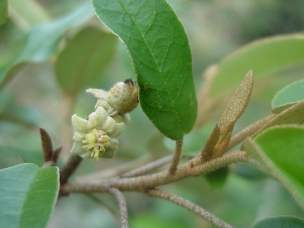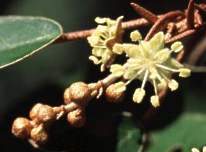Croton gratissimus
Croton gratissimus Burch.
Family: Euphorbiaceae
Common names: bergboegoe, ilabele, inkubathi, isikhumampuphu, korannaboegoe, lavender croton, lavender fever berry, laventelbos, laventelkoorsbessie, maloga
SA Tree No: 328
Introduction
This is an attractive and versatile deciduous shrub or small tree in the home garden, but capable of becoming a large tree in certain instances.

Description
Description
C. gratissimus is a shrub or a small tree that may reach 10 m in height in South Africa, but can grow to 20 m tall further north in Africa. It is a slender tree with fine, drooping foliage and a crown which spreads upwards in a 'V'-shape with drooping terminal branches.
The leaves of the lavender croton are simple and alternate, with a beautiful and striking silvery under-surface. The upper surface is dark green and shiny, without hairs, while the under surface is covered by dense scales producing a silvery colour. Leaves are also dotted with cinnamon coloured glandular scales.

C. gratissimus bears small cream to golden yellow flowers in spikes of about 10 cm long. The small buds are formed and stay on the tree for months before the flowers open. Spikes contain different sex flowers, with only one or two females at the bottom of the spike, and the rest are males.
Fruit, formed between September and November, is a three lobed capsule. First green, it turns yellow as it matures. In late autumn the capsule dries out and explodes flinging the seed some distance from the mother plant.
Distribution and habitat
Distribution description
The tree occurs only in the northern parts of South Africa, with its main distribution further north. According to Coates Palgrave (2002) it over a wide range of altitudes, in a variety of woodland vegetation types but mainly associated with stony soils and rocky outcrops.
Derivation of name and historical aspects
History
The spurge family (Euphorbiaceae) is a large family of flowering plants with 280 genera and around 6,000 species. Most are herbs, but some, especially in the tropics are also shrubs or trees. Some are succulent and resemble cacti. This family occurs mainly in the Tropics, with the majority of the species in the Indo-Malayian region and tropical South America coming a good second. However, Euphorbia also has many species in non-tropical areas such as the Mediterranean, the Middle East, South Africa and southern USA.
Croton is an extensive plant genus of the family Euphorbiaceae established by Carolus Linnaeus in 1737. The common name for this genus is rushfoil and croton. The genus name comes from Greek Kroton, which means ticks, because of the seeds' ressemblance to ticks. The species name gratissimus is a Latin word meaning 'most pleasing' (gratus = pleasing; -issimus = most).
Croton gratissimus has been divided into two varieties, namely; C. gratissimus var. gratissimus and C. gratissimus var. subgratissimus. Variety gratissimus has no hairs on the upper surface, while variety subgratissimus has stellate hairs on the upper surface and occurs mainly in Zimbabwe, Botswana and the far northern areas of South Africa.
Uses
Use
The young branches of lavender croton are pleasantly aromatic; and it is recorded that Bushman girls dried these and then powder them to make perfume. The charred and powdered bark is used to treat bleeding gums. Although the plant is believed to be toxic, it is an important stock food in Namibia. It is also a beautiful ornamental plant with pale bark and attractive foliage.
Growing Croton gratissimus
Grow
The seed should be collected just before it is dispersed and stored in a dry closed container where it will open spontaneously. The seed should be sown in a well drained open seedling mixture and covered lightly with the same mixture or fine sand.
The trays should be kept in a light place and watered regulary but not kept too wet until germination takes place (usually between 3-4weeks). Once the seedlings have established watering should be reduced and a fungicide may be applied to prevent damping off.
Seedlings should be allowed to grow to approximately 50 mm before being transplanted into individual containers. Saplings are slow growing at first but the growth rate increases, as the plants get older. Plants may be planted out into the garden once they are 600 mm or taller.
References
- Coates Palgrave, M., 2002. Keith Coates Palgrave Trees of Southern Africa. Struik Publishers: Cape Town.
- Schmidt, E., Lötter, M. and McCleland, W., 2002. Trees and Shrubs of Mpumalang and Kruger National Park. Jacana: Johannesburg
- Van Wyk, B., & van Wyk P., 1997. Field Guide to Trees of Southern Africa. Struik Publishers: Cape Town
Credits
Mhlonishwa D. Dlamini
Walter Sisulu National Botanical Garden
December 2005
Plant Attributes:
Plant Type: Tree
SA Distribution: Gauteng, KwaZulu-Natal, Limpopo, Mpumalanga, North West, Northern Cape
Soil type: Loam
Flowering season: Spring, Early Summer, Late Summer
PH: Neutral
Flower colour: Cream, Yellow
Aspect: Full Sun
Gardening skill: Easy
Special Features:
Horticultural zones









Rate this article
Article well written and informative
Rate this plant
Is this an interesting plant?
Login to add your Comment
Back to topNot registered yet? Click here to register.